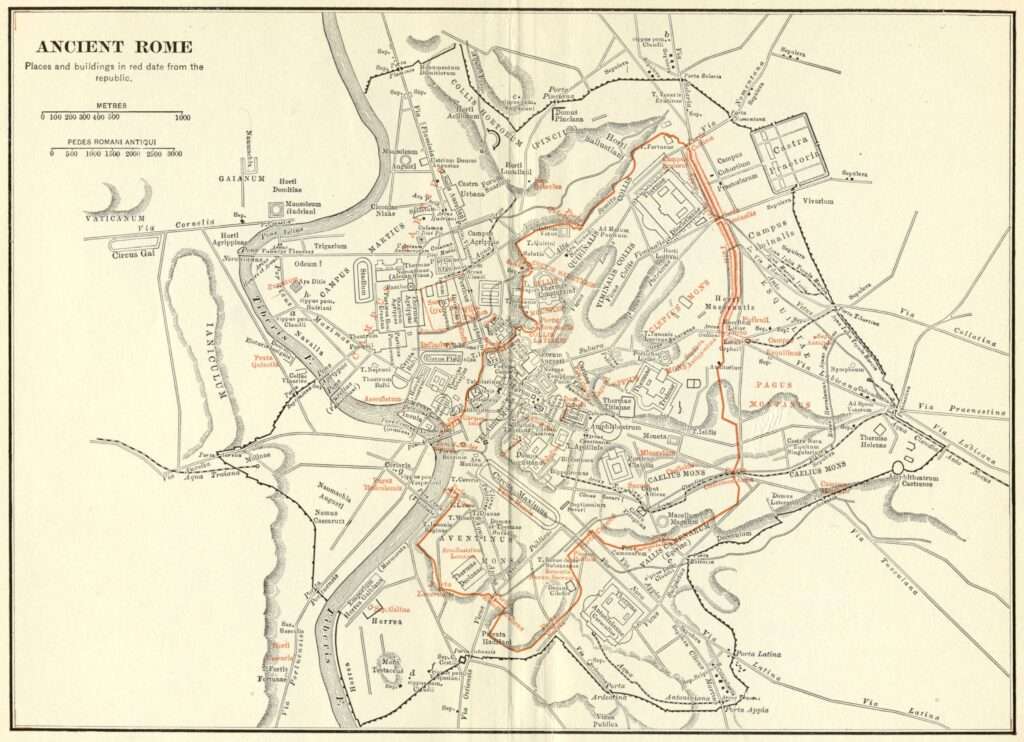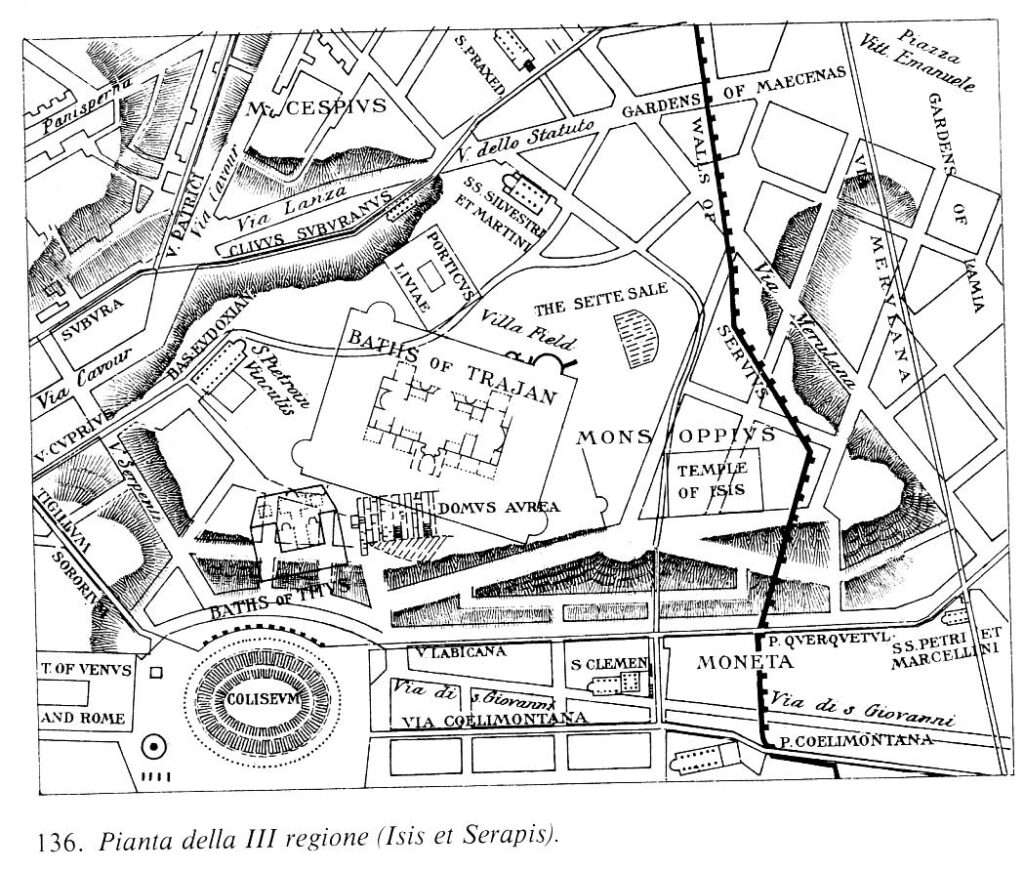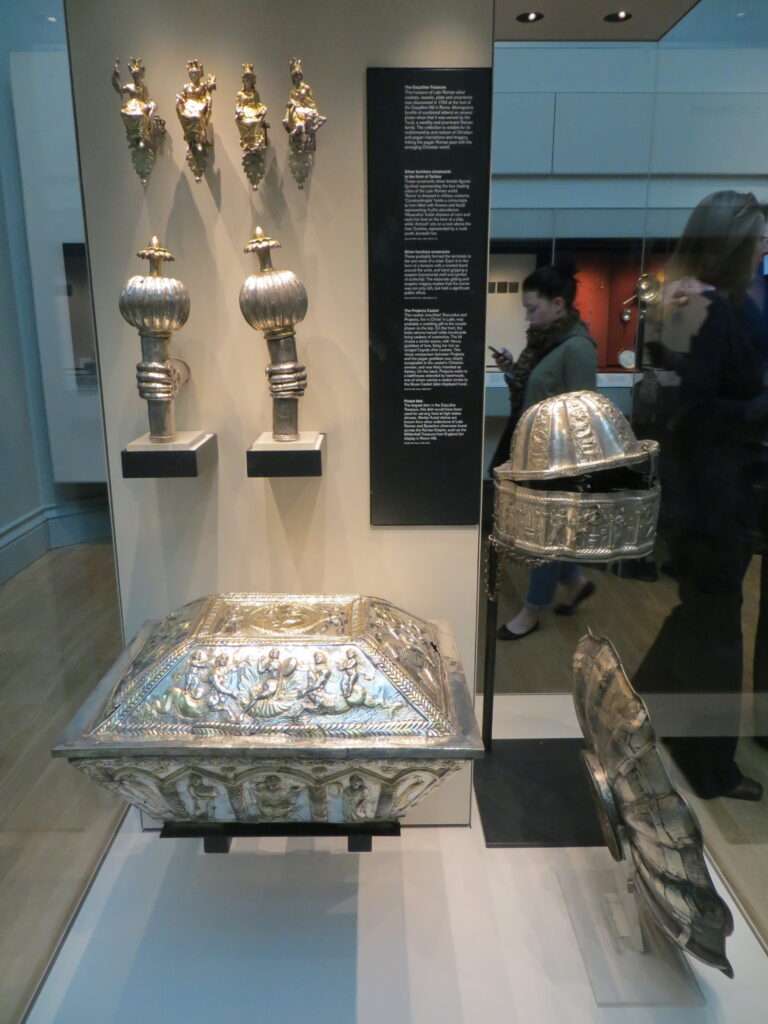One of the Seven Hills of Rome, the Esquiline Hill was the home of many structures and played a crucial role in the defenses of this ancient civilization.
Location
Looking at a map of the ancient city, the Esquiline Hill is located on the eastern side of the ancient city.
The Esquiline Hill is the largest of the Seven Hills. It has two outcrops or “spurs”, which were known as ‘hills’ as well – The Cispian Hill (Mons Cispius) and the Oppian Hill (Mons Oppius). There was a further spur called the Fagutalis, but historians believe that due to its small size and proximity to the Oppian Hill, the name Oppian became synonymous with both locations.
The hill was incorporated into the ancient city’s boundaries over time, with the Servian Wall and Servian Agger cutting through the middle of the hill from north to south. The Agger was an earthen ditch in front of the wall that helped strengthen the defenses at a place that was a weak point for Rome.
As time went on and the city grew, it pushed past the boundaries of the Servian Wall, where Emperor Aurelian eventually enclosed it with his defensive upgrades in the late third century AD.
To the immediate west of the hill (almost at the base), in between the Cispian and Oppian Hills, one would find the Porticus of Livia (Porticus Liviae).
The Oppian Hill outcrop brought the overall Esquiline Hill close to the heart of the city, with the Temple of Venus and Roma (Templum Veneris et Romae), Basilica of Constantine (Basilica of Maxentius), and the Temple of Peace immediately west of it. The Baths of Titus were located at the base of the Oppian Hill.
Venturing to the southern side of the hill, one would come across the Colosseum, the Ludus Magnus, the Imperial mint (Moneta Ceasaris), and the Temple of Isis (supposedly built on the slope of the hill. These structures were built in the valley between the Esquiline and Caelian Hills (located further south).

As the Esquiline Hill was eventually wholly enclosed in the city after the building of the Aurelian Wall, there was nothing of note further east of the wall. However, a few aqueducts enter the city near the convergence of the Esquiline and Caelian Hills.
The Aqua Julia and Aqua Tepula Marcia were incorporated into the Aurelian Walls in parts before heading further into the city.
To the north of the Esquiline Hill, one would find the Castra Praetoria (the camp of the Praetorian Guard), the associated Campus Cohortium Praetoriarum, and the Baths of Diocletian.
To the northwest is the Viminal Hill, with the Quirinal Hill located on the far side of that.
Many gardens were found on the Esquiline Hill, where wealthier citizens resided. No less than eight gardens were known to have been located on the hill: Horti Lolliani, Horti Tauriani et Calyciani, Horti Pallantiani, Horti Maecenatis, Horti Epaphroditiani, Horti Liciniani, Horti Lamiani and Horti Torquatiani.
We can get a small insight into the type of people that lived on the Esquiline Hill in the writings of first and second-century AD poet Martial. He writes to an acquaintance, Maximus, in Book VII, LXXIII:
“You have a mansion on the Esquiline hill, and a mansion on the hill of Diana; and another rears its head in the Patricians’ quarter. From one of your dwellings you behold the temple of the widowed Cybele, from another that of Vesta; from others you look on the old and the new Capitol. Tell me where I may meet you; tell me whereabouts I am to look for you: a man who lives everywhere, Maximus, lives nowhere.”
Over the centuries, other structures found on the Esquiline Hill include the Macellum Liviae (markets of Livia), Baths of Trajan, Nero’s Domus Aurea, Temple of Minerva Medica, and Nymphaeums.
A few ancient Roman gates were located on the Esquiline Hill. The Servian Wall had been built through the middle of the hill, so at least two gates were present—the Porta Viminalis and the Porta Esquilina.
The other gates were formed when the Aurelian Wall was built late in the third century AD. These were the Porta Praenestina (Porta Maggiore), Porta Tiburtina, and an unknown gate located on the southwestern side of the Castra Praetoria.
Unfortunately, the Porta Viminalis has not survived the reconstruction projects undertaken over the centuries. Historians believe that the Porta Viminalis was located on the site or near the modern Termini Railway station. The preserved Servian Wall just outside the station and the proximity to the old Castra Praetoria give us confidence in the gate’s location.
The Porta Esquilina has survived to modern-day as it was rededicated as the Arch of Gallienus in the late third century AD.
The remaining gates, the Porta Praenestina (Porta Maggiore) and the Porta Tiburtina have both survived, while the gate next to the Castra Praetoria has disappeared.
History
When Romulus founded it, Esquiline Hill was not part of the city of Rome. It was not part of Rome until the city’s boundaries were expanded by Rome’s sixth king, Servius Tullius, who reigned around 578-535 BC. To encourage people to move to the newly expanded areas of the city, King Servius lived on the hill.
As noted by Livy in his works, The History of Rome, Book I, XLIV.III:
“To contain that population, it was obvious that the City would have to be enlarged. He added to it the two hills —the Quirinal and the Viminal —and then made a further addition by including the Esquiline, and to give it more importance, he lived there himself. He surrounded the City with a mound and moats and wall; in this way, he extended the pomerium.”
In his book Geography, Strabo describes the early foundations of Rome and how the city expanded, confirming that Servius Tullius included the Esquiline Hill out of necessity for the city’s defense because it was an area prone to enemy attacks. He also notes the building of three gates – the ‘Colline Gate’ (Porta Collina), Esquiline (Porta Esquilina), and the gate ‘bearing the same name as the Viminal Hill (Porta Viminalis). Book V, III.VII:
“In the interior, the first city above Ostia is Rome, and it is the only city that is situated on the Tiber. With regard to this city, I have already said that it was founded there as a matter of necessity, not as a matter of choice, and I must add that even those who afterwards added certain districts to the settlement could not, as masters, take the better course, but as slaves must needs accommodate themselves to what had already been founded. The first founders walled the Capitolium and the Palatium and the Quirinal Hill, which last was so easy for outsiders to ascend that Titus Tatius took it at the first onset, making his attack at the time when he came to avenge the outrage of the seizure of the maidens.Again, Ancus Marcius took in Mt. Caelium and Mt. Aventine and the plain between them, which were separated both from one another and from the parts that were already walled, but he did so only from necessity, for, in the first place, it was not a good thing to leave hills that were so well fortified by nature outside the walls for any who wished strongholds against the city, and, secondly, he was unable to fill out the whole circuit of hills as far as the Quirinal. Servius, however, detected the gap, for he filled it out by adding both the Esquiline Hill and the Viminal Hill. But these, too, are easy for outsiders to attack, and for this reason, they dug a deep trench and took the earth to the inner side of the trench, and extended a mound about six stadia on the inner brow of the trench, and built thereon a wall with towers from the Colline Gate to the Esquiline. Below the center of the mound is a third gate, bearing the same name as the Viminal Hill.”

By Lalupa – CC BY-SA 3.0
The Esquiline Hill featured during the Civil War between Marius and Sulla in the first century BC. As Sulla marched on Rome from the south, he was met by representatives from the city, requesting that he not attack. He told the representatives that he would not, before going back on his word and captured the defenses on the Esquiline Hill, before going further and wreaking havoc within the city itself.
Plutarch notes this incident in his book, The Parallel Lives – The Life of Sulla, IX.V:
“When he had reached Pictae, he was met by a deputation from the city, which begged him not to advance to an immediate attack since the senate had voted that he should have all his rights; he therefore agreed to encamp there, and ordered his officers to measure out the ground, as was usual, for the camp, so that the deputation returned to the city believing that he would do so. But no sooner were they gone than he sent forward Lucius Basillus and Caius Mummius, who seized for him the city gate and the walls on the Esquiline hill; then he himself followed hard after them with all speed. Basillus and his men burst into the city and were forcing their way along when the unarmed multitude pelted them with stones and tiles from the roofs of the houses, stopped their further progress, and crowded them back to the wall. But by this time, Sulla was at hand, and, seeing what was going on, shouted orders to set fire to the houses and, seizing a blazing torch, led the way himself and ordered his archers to use their fire bolts and shoot them up at the roofs.”
We know that Emperor Tiberius lived on the Esquiline Hill for a period of his life, thanks to the writings of Suetonius. In his book, The Lives of the Caesars – The Life of Tiberius, XV.I, he writes:
“On his return to Rome, after introducing his son Drusus to public life, he at once moved from the Carinaeand the house of the Pompeys to the gardens of Maecenas on the Esquiline, where he led a very retired life, merely attending to his personal affairs and exercising no public functions.”
Suetonius writes about Emperor Nero and his fondness for building projects. He writes about the emperor’s extravagant palace, the Domus Aurea, that was built in the aftermath of the Great Fire of Rome in AD 64 in his book, The Life of the Caesars – The Life of Nero, XXXI.I:
“There was nothing, however, in which he was more ruinously prodigal than in building. He made a palace extending all the way from the Palatine to the Esquiline, which at first he called the House of Passage, but when it was burned shortly after its completion and rebuilt, the Golden House. Its size and splendour will be sufficiently indicated by the following details. Its vestibule was large enough to contain a colossal statue of the emperor a hundred and twenty feet high; and it was so extensive that it had a triple colonnadea mile long. There was a pond too, like a sea, surrounded with buildings to represent cities….”
While the writings about figures such as Nero were over the top at times, there was no mistaking the extravagance of his palace. The ‘pond’ that Suetonius refers to was a vast artificial lake Nero had included in the palatial grounds. This was eventually drained and the Colosseum was built in its place.
In more modern times, excavations were carried out on the Esquiline Hill. In 1793, a horde of Roman silver containing around 380 pieces was discovered. This became known as the Esquiline Treasure, dating to the fourth century AD. This is further evidence that the Esquiline Hill was an area for the wealthy, even during the waning years of the Empire.
Archeologist Rodolfo Lanciani wrote an interesting piece about sanitation in the ancient city in his book Ancient Rome in the Light of Recent Discoveries (1898). He writes about the discovery of a Roman altar to the god Verminus, who was the god that protected cattle from disease. Page LII:
“The clearest proof of the virulence of malaria in the first century of the history of Rome is afforded by the large number of altars and shrines dedicated by its early inhabitants to the goddess of the Fever and other kindred divinities. At the time of Varro, there were not less than three temples of the Fever left standing: one on the Palatine, one in the square of Marius on the Esquiline, one on the upper end of the Vicus Longus, a street which corresponds, within certain limits, to the modern Via Nazionale. The Esquiline quarter seems to have been the worst of all in its sanitary conditions; in fact, besides the Fever’s temple, there was an altar dedicated to the Evil Eye (Mala Fortuna), and an altar and small wood dedicated to the goddess Mefitis. Near the Praetorian camp, and near the modern railway station, I have found, myself, an altar consecrated to Verminus, the god of microbes; and lastly, in the very centre of the Roman Forum, there was an altar sacred to Cloacina, a goddess of typhoid, I suppose.”
What is now on the Esquiline Hill?
Besides the numerous Roman ruins still in existence, several notable places occupy the Esquiline Hill.
The most notable site on the hill is the Roma Termini railway station. It is the main train station in Rome and was opened in 1862. It sits where a portion of the Servian Wall used to run, near the Castra Praetoria.

By Jononmac46 – CC BY-SA 3.0
The Basilica di Santa Maria Maggiore lies on the Cispian spur of Esquiline Hill. It was first built under Pope Celestine I in AD 422-432, and numerous additions and reconstructions were undertaken over the centuries.
The Basilica of Saint Peter in Chains (San Pietro in Vincoli) was built on the Oppian spur of the Esquiline Hill. It was built in AD 432-440 and was said to have housed the chains that bound St Peter. It was added to and rebuilt many times over the centuries, with the last major renovation taking place in 1875.
There are many churches on the Esquiline Hill, with an estimated 900 churches in Rome.
Sources:
Epigrams – Martial (tertullian.org)
The History of Rome – Livy (Perseus Digital Library)
Geography – Strabo (Thayer)
The Parallel Lives – The Life of Sulla – Plutarch (Thayer)
The Lives of the Caesars – The Life of Tiberius – Suetonius (Thayer)
The Lives of the Caesars – The Life of Nero – Suetonius (Thayer)
Ancient Rome in the Light of Recent Discoveries – Rodolfo Lanciani (Thayer)

